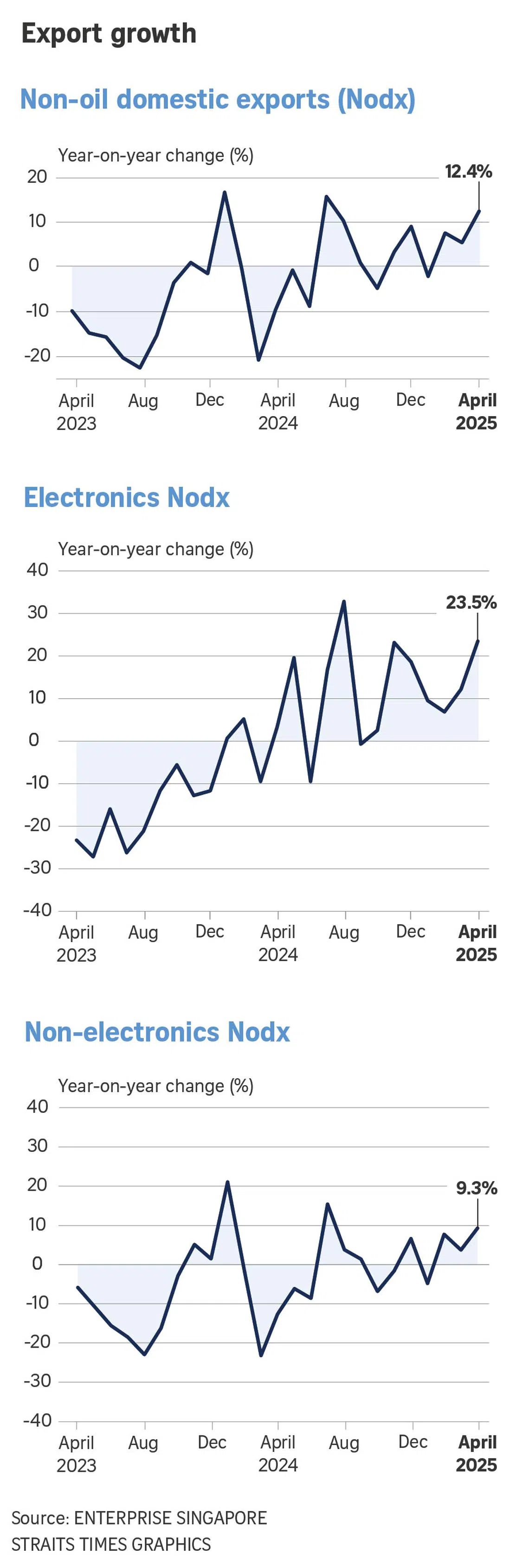Singapore key exports surge 12.4% in April, much more than expected
Sign up now: Get ST's newsletters delivered to your inbox

Non-oil domestic exports surged 12.4 per cent year on year in April, compared with a 5.4 per cent rise in the previous month.
ST PHOTO: LIM YAOHUI
Follow topic:
SINGAPORE - Singapore’s key exports grew at a faster-than-expected pace in April, boosted by stronger shipments of both electronics and non-electronics as customers front-loaded orders amid US President Donald Trump’s tariff reprieves.
Economists said Singapore will continue to benefit from the reprieves for the next few months, but the export outlook remains clouded for when the 90-day “tariff windows”
In April, non-oil domestic exports (Nodx) surged 12.4 per cent year on year, compared with a 5.4 per cent rise in the previous month, according to figures released by trade agency Enterprise Singapore on May 16.
April’s increase far outstripped the 4.3 per cent growth forecast by analysts in a Bloomberg poll.
Electronics exports expanded 23.5 per cent year on year, almost double the 12.2 per cent growth in March. Growth was underpinned by personal computers, disk media products and integrated circuits.
Non-electronics exports grew 9.3 per cent in April, higher than the revised 3.7 per cent increase in March.
Economists said customers took advantage of Mr Trump’s 90-day suspension of global reciprocal tariffs – excluding China – announced on April 9 and his exemption of electronics from levies
The US and China subsequently announced on May 12 a deal to slash tariffs
OCBC Bank chief economist Selena Ling noted that overall Nodx was the highest since July 2023, while electronics Nodx was the strongest since November 2023.
“With the 90-day slashing of tariffs between China and the US, and the various ongoing trade negotiations, these few months could be a relief window where front-loading potentially continues until there is better clarity,” she said.
DBS Bank senior economist Chua Han Teng said that exporters are likely to capitalise on the temporarily lowered tariffs by front-loading export orders, which will benefit Singapore’s near-term exports performance.
But he cautioned: “While the temporary de-escalation of US-China trade tensions is a positive, global trade frictions remain higher than before, which we expect to still dampen Singapore’s exports performance in 2025, even if less severe than previously anticipated.”
Non-monetary gold led the charge with an 80.4 per cent expansion, while structures of ships and boats as well as specialised machinery rose by 7.2 per cent.

Nodx to Indonesia, Taiwan and South Korea grew, though shipments to Malaysia and China – Singapore’s single largest export market – declined.
The main drag on Nodx was China, which saw a 17 per cent drop in shipments compared with a revised 29.5 per cent plunge in March.
Shipments to the US grew 1.2 per cent in April, a sharp drop from the revised 6.2 per cent growth in March.
Exports to Indonesia surged 111.2 per cent in April – following a revised 62.9 per cent growth in the preceding month – thanks to structures of ships and boats, non-monetary gold and personal computers.
Shipments to Taiwan grew by 47.4 per cent in April, following the 45.7 per cent expansion in the preceding month, due to specialised machinery, integrated chips and measuring instruments.
Nodx to South Korea expanded by 38.1 per cent in April, following the 21.6 per cent growth in March, due to specialised machinery, integrated chips and personal computers.
Maybank Research senior economist Chua Hak Bin said the easing of US-China trade tensions has reduced recession risks for Singapore and improved the near-term export outlook.
He noted that Singapore currently faces a relatively low reciprocal tariff of 10 per cent and an effective US tariff rate of 4.6 per cent, due to exemptions for semiconductors, pharmaceuticals and electronics.
“Looking ahead, Singapore’s export outlook will be dampened if the US proceeds with the sector tariffs on semiconductors and pharmaceuticals,” Dr Chua said.


